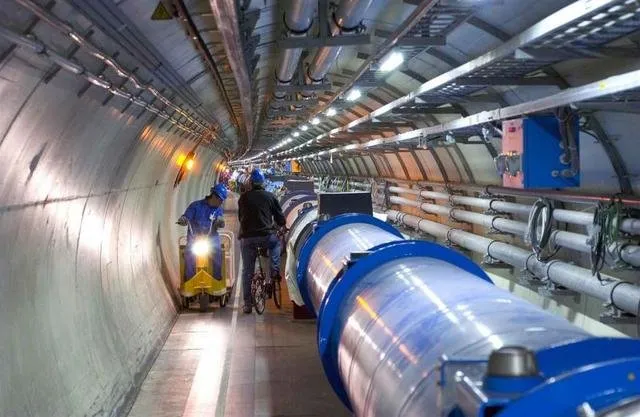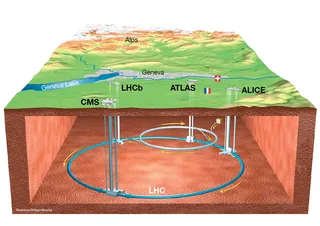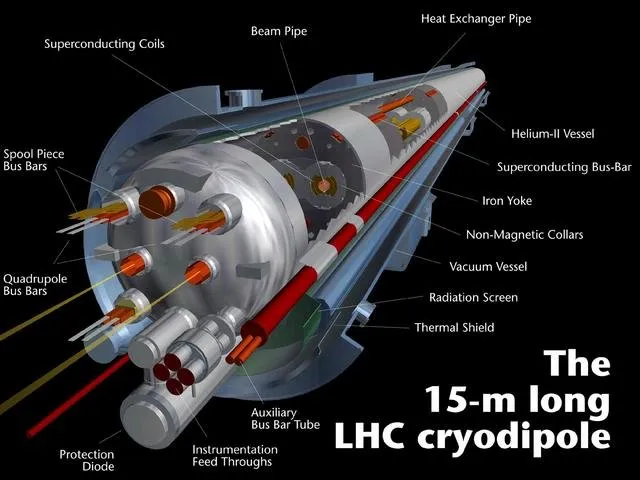After having discussed the theory of the Standard Model in the first four posts of this particle physics crash course for STEEM, the challenges connected to new phenomena in the fifth post, it is now time to turn to the experimental side, and in particular to accelerators and colliders.

In particular, I will introduce the largest experimental complex that has never been built by humans, the Large Hadron Collider (or the LHC) at CERN, in Geneva (Switzerland).
Thanks the the LHC, the Standard Model of particle is tested into (almost) all of its details, and physicists are looking forward to witness the discovery of new phenomena in a hopefully not too far future. The LHC is also the machine that 20 of us will see in a week, going down 100 meters underground (see here for more information).
For those only interested in funny amazing facts about the LHC, please go down directly to the last section of this article.
PARTICLE ACCELERATORS - THE PRINCIPLE
In order to test our theoretical frameworks, particle physicists have designed large accelerators in which subatomic particles are accelerated, as it could be guessed from the name.
By bringing particles to significant velocities (i.e. by accelerating them), we actually increase their kinetic energy. Therefore, once two of these particles are smashed (or collided), we have plenty of energy available to produce known (and potentially unknown) phenomena.
This is another way to quote Einstein: the production of new massive particles requires large energies, as mass equals energy. It is good to remind that neither the number of particles nor the mass are conserved. This is subatomic physics after all: only the total amount of energy matters (and is conserved).

[image credits: CERN]
But how does all of this work? The idea is very simple. First, we begin with the fundamental principle of dynamics, also known as Newton’s laws of motion.
This law tells us that the force applied to a system is proportional to its acceleration. Therefore, if one wants to accelerate an object, we need to apply some force on it.
Next, one needs to think about how to produce this force. And the idea here is again pretty simple. The particles that we want to accelerate are electrically charged, so that one could rely on the Lorentz force and have fun with electric and magnetic fields.
An electric field will induce a force parallel to it, while a magnetic field will induce a force perpendicular to the velocity and the field.
In other words, electric fields are used to accelerate the particles and magnetic fields are used to control their trajectories.
THE LARGE HADRON COLLIDER AT CERN
Just to insist a little bit: I said hadrons, not hardons…

[image credits: LHC@home]
The LHC is the largest collider machine ever built, and it is located at CERN, across France and Switzerland. It is a ring of 27 kilometers long, buried under the ground at a depth ranging from 45 meters to 170 meters.
The CMS experiment that we will visit is roughly buried at 100 meters under the ground (which is why we will have no 4G in there, so no D-live).
We have actually two rings (inside one tunnel of course), inside which two beams of particles are accelerated and collided at four interaction points (see the figure on the left).
Although the LHC is very well known for accelerating and colliding protons, other types of particles like lead or xenon ions are smashed in there as well. The idea is here to try to shed light on what happened during the very first moment of the universe. This contrasts with proton collisions that are dedicated to the test of the Standard Model and the unraveling of new phenomena.
THE LHC OR PLENTY OF WORLD RECORDS
I now collect a bunch of fun amazing facts about the LHC.
In the LHC tunnel, protons are accelerated at 99.9999999% of the speed of light before being smashed against each other. Yep, this is fast! And actually very energetic… The energy stored within a beam corresponds to the energy of a high speed train (French TGV or German ICE) circulating at 150 km/h!
This means that one collision will happen at an energy larger than the one in the center of the hottest stars!

[image credits: CERN]
This acceleration has been made possible thanks to powerful magnets. Those magnets generate a super-intense magnetic field 100.000 times stronger than the magnetic field of Earth. Another record!
No worries, the machine will be turned of when we will go down inside it.
In order to provide some power to our magnets, one delivers an electric current of 12000 Amperes at a temperature cooler than the one of the void in the universe (1.9 Kelvin). For the sake of comparison, we have roughly 100 Amperes at home…
In terms of electrical power, this corresponds to 120 MW, that is the power provided to all houses in the Geneva canton in Switzerland. Another huge number :)
We cannot speak about the records of the LHC without mentioning the moon… Inside the LHC, the beam circulate in a vacuum of 10-13 bar, which is 10 times less than the pressure… on the moon.
[x] Mentioning the word ‘moon’ in a post that does not discuss the moon: done.
Finally, just to bring one fact from my previous post, we have about one billion collisions per second, and most these collisions are boring… We need to reduce this number by (at least) 10.000.000.000.000 by cleverly selecting the events that are interesting for Higgs physics, top physics, etc.
SUMMARY
In this post, I detailed the basic principles behind particle accelerators, and how we actually accelerate particles. I have then given some details about the LHC before explaining why this machine is just the most amazing machine ever built (okay, my subjective opinion here).
More information can be found on the LHC website, for those who may be interested.
And finally, the previous episodes of this series can be found here: #1, #2, #3, #4 and #5.
SteemSTEM
SteemSTEM is a community-driven project that now runs on Steemit for more than a year. We seek to build a community of science lovers on Steemit and to promote well written/informative Science Technology Engineering and Mathematics (STEM) postings in order to make Steemit a place for fascinating STEM content.
More information can be found on the @steemstem blog and on the Steemit chat and in our last project report.
